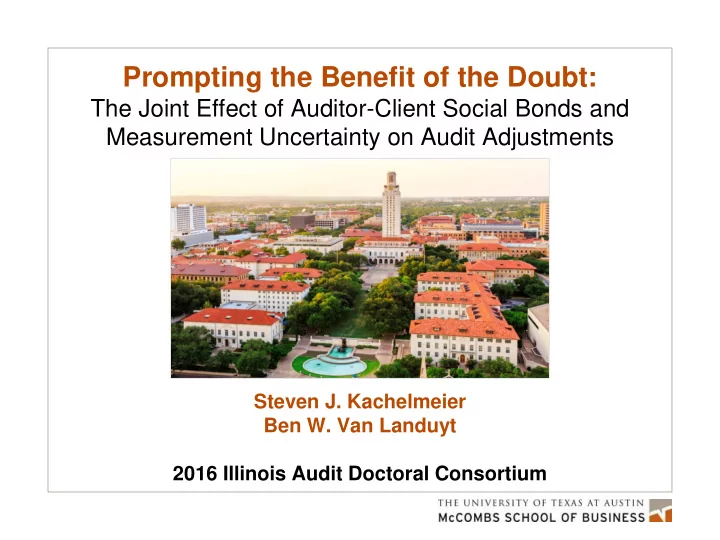

Prompting the Benefit of the Doubt: The Joint Effect of Auditor-Client Social Bonds and Measurement Uncertainty on Audit Adjustments Steven J. Kachelmeier Ben W. Van Landuyt 2016 Illinois Audit Doctoral Consortium
The problem: Why do audits fail? One reason: Failure of independence • The auditor found the misstatement but did not correct it. But, if auditors are willing to “look the other way,” why bother to look for a misstatement in the first place? Maybe auditors look the other way only when there is uncertainty surrounding the misstatement.
Why this problem is important Separate streams of research show that 1) impaired independence 2) measurement uncertainty are detrimental to auditor judgments. Prior research does not directly show how these constructs impact each other. This is critically important is a world where 1) even subtle aspects of auditor-client Social bonds relationships can threaten independence 2) accounting values are increasingly characterized by measurement uncertainty
What we do and what we find Incentivized experiment in the traditions of experimental economics. Student participants interact in pairs , with roles analogous to a reporter and an auditor. Manipulations: the social bond between auditors and reporters and measurement uncertainty present in the available audit evidence. Primary dependent variable: the amount of audit adjustment required by the auditor. Results: Lower audit adjustments occur only in the cell with social bonds and measurement uncertainty.
Theory How do auditors respond once they have found a (potential) misstatement? Measurement Audit Uncertainty Adjustments • Wright and Wright 1997; Libby and Kinney 2000; Braun 2001; Griffin 2014 • The Leniency Heuristic (Ganzach and Krantz 1991) Auditor/Client Audit Social Bonds Adjustments • Social Identity Theory (Tajfel 1978; Ashforth et al. 2008) • Bamber and Iyer 2007; Bauer 2015; Koch and Salterio 2015
Hypothesis Measurement Uncertainty Audit Adjustments ? Auditor/Client Social Bonds Independence × Uncertainty Audit Adjustments Independent auditor Socially bonded auditor Measurement Measurement Certainty Uncertainty
Research design: Manipulations Factor 1: Social Bond (Independence) Before the main experiment, participants spend five-minutes answering general knowledge trivia questions in pairs or individually . Factor 2: Measurement uncertainty Later, in the reporter- auditor game, the auditor’s signal either reveals the reporter’s action with certainty or it is highly diagnostic but not definitive .
Research design: The reporter-auditor game Reporters start out with fixed pay of $15. Each reporter then adds five marbles to a bag. Marbles added can be red or white. Each red marble added pays the reporter $2. Each white marble added pays zero. The z-Tree computer interface describes the experiment in this manner, but there is no actual bag, nor are there any actual marbles.
Research design: The reporter-auditor game Each red marble the reporter adds to the bag increases the probability that the auditor will incur a $15 penalty. Auditors can protect themselves from this penalty by removing red marbles. Red marbles remaining p($15 penalty) 0 5% 1 20% 2 35% 3 55% 4 75% 5 95%
Research design: The reporter-auditor game Auditors start out with fixed pay of $25. Auditors receive a signal about the number of red marbles added, analogous to audit evidence. Auditors can remove red marbles up to the number signaled. Each red marble removed by the auditor costs the auditor $2. With 60% probability, the reporter is charged $3 for each red marble removed.
Research design: The reporter-auditor game Nash equilibrium: Reporters should add five red marbles. Auditors should remove the maximum number of red marbles allowed by the signal received.
Research design: The auditor’s signal Certainty condition: The auditor’s signal simply reveals the number of red marbles added, with certainty. Bag is empty Assume the reporter adds The auditor’s signal to begin with five red marbles
Research design: The auditor’s signal Uncertainty condition: The auditor’s signal is diagnostic but not conclusive of the number of red marbles added. Bag has five red and Assume the reporter adds The auditor’s signal five white marbles to five red marbles begin with
Research design: The auditor’s decision We use the “strategy method” to elicit how many red marbles the auditor wishes to remove for each potential signal. Signal received Red marbles removed N/A 0 or 1 0, 1, or 2 0, 1, 2, or 3 Our primary 0, 1, 2, 3, or 4 analysis 0, 1, 2, 3, 4, or 5
Results: Primary analysis Audit adjustments when signal = 5 red marbles: 5 Red marbles removed 4.5 No social bond 4 p > 0.50 p < 0.01 3.5 Social bond 3 2.5 Certainty Uncertainty
Results: Primary analysis Audit adjustments across ALL possible signals: 12 Red marbles removed No social bond p > 0.50 11 p = 0.03 10 9 Social bond 8 Certainty Uncertainty
Results: Reporter behavior How do REPORTERS respond to the social bond? 4 Red marbles added by reporter No social bond 3.5 p = 0.04 Social bond 3 2.5 Certainty Uncertainty
Results: Possible alternate explanation? Given reporter behavior, a lower audit adjustment is justified in the condition with a social bond. Supplemental analysis of conditions with measurement uncertainty using Bayes’ Rule allows us to control for: • auditors’ expectations of reporter behavior • actual reporter behavior Auditors face exposure to more risk in the presence of the social bonds.
Conclusions When a misstatement is known , impaired independence does not result in impaired judgments. Likewise, measurement uncertainty does not bias auditor judgments when auditors are independent. However, when uncertainty is present, social bonds unrelated to auditors’ economic incentives, prompt auditors to give clients the benefit of the doubt . Auditing complex or uncertain areas presents not only technical, but behavioral challenges.
Thank You!
Recommend
More recommend